
North Borneo was a British protectorate in the northern part of the island of Borneo, which is present day Sabah. The territory of North Borneo was originally established by concessions of the Sultanates of Brunei and Sulu in 1877 and 1878 to a German-born representative of Austria-Hungary, a businessman and diplomat, Gustav Overbeck.

Sandakan formerly known at various times as Elopura, is the capital of the Sandakan District in Sabah, Malaysia. It is the second largest city in Sabah after Kota Kinabalu. It is located on the Sandakan Peninsula and east coast of the state in the administrative centre of Sandakan Division and was the former capital of British North Borneo. In 2010, the city had an estimated population of 157,330 while the overall municipal area had a total population of 396,290. The population of the municipal area had increased to 439,050 by the 2020 Census.
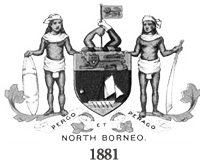
The North Borneo Chartered Company (NBCC), also known as the British North Borneo Company (BNBC) was a British chartered company formed on 1 November 1881 to administer and exploit the resources of North Borneo. The territory became a protectorate of the British Empire in 1888 but the company remained involved with the territory until 1946, when administration was fully assumed by the Crown colony government.

The history of Sabah can be traced back to about 23–30,000 years ago when evidence suggests the earliest human settlement in the region existed. The history is interwoven with the history of Brunei and the history of Malaysia, which Sabah was previously part of and is currently part of respectively. The earliest recorded history of Sabah being part of any organised civilisation began in the early 15th century during the thriving era of the Sultanate of Brunei. Prior to this, early inhabitants of the land lived in predominantly tribal societies, although such tribal societies had continued to exist until the 1900s. The eastern part of Sabah was ceded to the Sultan of Sulu by the Sultan of Brunei in 1658 for the former helping a victory over Brunei enemies, but many sources stated it had not been ceded at all. By the late 19th century, both territories previously owned by Sultan of Brunei and Sultan of Sulu was granted to British syndicate and later emerged as British North Borneo under the management of the North Borneo Chartered Company. Sabah became a protectorate of the United Kingdom in 1888 and subsequently became a Crown colony from 1946 until 1963, during which time it was known as Crown Colony of North Borneo. On 16 September 1963, Sabah merged with Malaya, Sarawak and Singapore to form Malaysia.

Before the outbreak of World War II in the Pacific, the island of Borneo was divided into five territories. Four of the territories were in the north and under British control – Sarawak, Brunei, Labuan, an island, and British North Borneo; while the remainder, and bulk, of the island, was under the jurisdiction of the Dutch East Indies.

William Burgess Pryer was the first British Resident in Sandakan of North Borneo. Pryer's character is described as adventurous, diligent, and goal-oriented. For example, he knew that before exploring his career in Shanghai, he had explored large parts of the Spanish East Indies (Philippines), and he was a former amateur boxing champion.

Frank Hatton was an English geologist and explorer, who died young from an accidental shooting in the Bornean jungle. He was the second child of the journalist Joseph Hatton (1839–1907), who wrote a biographical preface to the book on North Borneo published posthumously based on field notes.
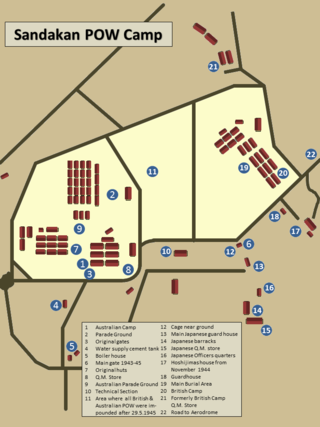
The Sandakan camp, also known as Sandakan POW Camp, was a prisoner-of-war camp established during World War II by the Japanese in Sandakan in the Malaysian state of Sabah. This site has gained notoriety as the Sandakan Death Marches started from here. Now, part of the former site houses the Sandakan Memorial Park.

Sandakan Heritage Trail is a trail connecting several historical sites in Sandakan, a town in the east Malaysian state of Sabah. It is marked with white concrete tiles placed on the ground showing a red footprint the words "Heritage Trail" in either black or gold.

The Sandakan War Monument is a monument established by the British located in the town of Sandakan, Malaysia, to commemorates the town citizens who died during the Second World War. The monument is part of the Sandakan Heritage Trails, a "Heritage Trail" which connects every historic sights of Sandakan.

William Pryer Monument is a monument that stand in the Malaysian town of Sandakan as a memory of the founder, William Burgess Pryer. It is part of the Sandakan Heritage Trails, a trail which connects all the historic sights in Sandakan.

Sandakan Massacre Memorial consists of three monuments which commemorate 30 Chinese victims, most of the members are local elite of an underground movement who been executed on 27 May 1945 along with several other victims during the Japanese occupation of North Borneo. The memorial was built on the spot where the massacre took place and where the victims were buried. It is located near a Chinese cemetery on a hill above the old town centre of Sandakan.

Cho Huan Lai Memorial or also known as Keningau War Memorial in the Malaysian town of Keningau in Sabah is a monument dedicated to Chinese Consul General Cho Huan Lai and his colleagues who died on 6 July 1945 after being executed by the Japanese.
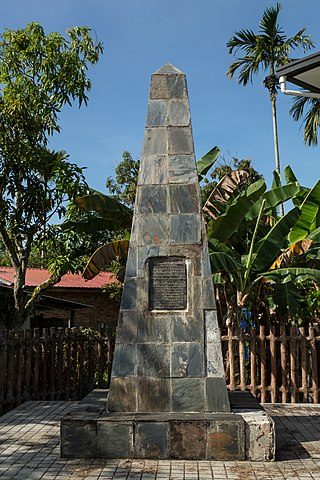
The De Fontaine Memorial is a monument built by the North Borneo Chartered Company to remember an incident on 12 May 1885 that led to an ambush attack to the North Borneo Armed Constabulary, in which five members of the police force were killed. The monument stands in the village of Kawang in the Malaysian state of Sabah.

St. Michael's and All Angels Church or for short St. Michael is an Anglican church in the city of Sandakan in the Malaysian state of Sabah in northern Borneo. St. Michael is the oldest stone church in Sabah. The impetus for the construction of the church dates back to the clergyman William Henry Elton, who is also known as the founder of St. Michael's Secondary School, located next to the church.
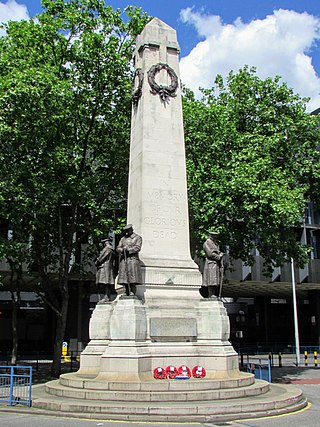
The London and North Western Railway War Memorial is a First World War memorial located outside Euston station in London, England. The memorial was designed by Reginald Wynn Owen, architect to the London and North Western Railway (LNWR), and commemorates employees of the LNWR who were killed in the First World War. Some 37,000 LNWR employees left to fight in the war—around a third of the company's workforce—of whom over 3,000 were killed. As well as personnel, much of the company's infrastructure was turned over to the war effort. Of the £12,500 cost of the memorial, £4,000 was contributed by the employees and the company paid the remainder.
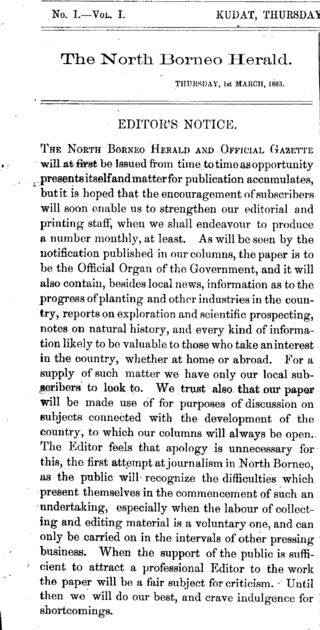
The British North Borneo Herald was a periodical magazine in British North Borneo, published between 1883 until 1941 by the government of North Borneo under various official names.

The Beluran District is an administrative district in the Malaysian state of Sabah, part of the Sandakan Division which includes the districts of Beluran, Kinabatangan, Sandakan, Telupid and Tongod. The capital of the district is in Beluran Town.

The Sandakan District is an administrative district in the Malaysian state of Sabah, part of the Sandakan Division which includes the districts of Beluran, Kinabatangan, Sandakan, Telupid, and Tongod. The capital of the district is in Sandakan City.

The Telupid District is an administrative district in the Malaysian state of Sabah, part of the Sandakan Division which includes the districts of Beluran, Kinabatangan, Sandakan and Tongod. The capital of the district is in Telupid Town. The district is formerly a part of Beluran District.
























